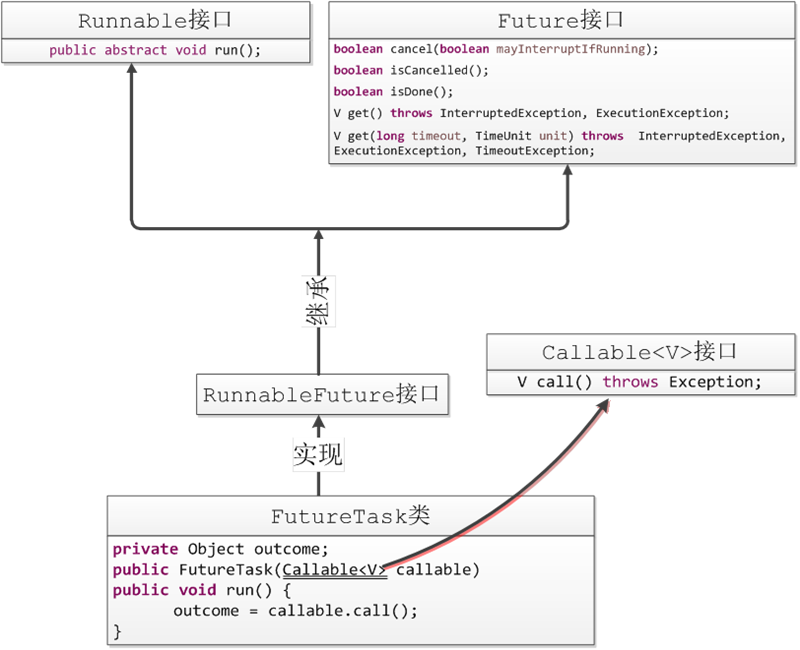1. Callable、Future、RunnableFuture、FutureTask的继承关系
在多线程编程中,我们一般通过一个实现了Runnable接口的对象来创建一个线程,这个线程在内部会执行Runnable对象的run方法。如果说我们创建一个线程来完成某项工作,希望在完成以后该线程能够返回一个结果,但run方法的返回值是void类型,直接实现run方法并不可行,这时我们就要通过FutureTask类来间接实现。
FutureTask实现了RunnableFuture接口,而RunnableFuture接口实际上仅仅是Runnable接口和Future接口的合体。Future接口提供取消任务、检测任务是否执行完成、等待任务执行完成获得结果等方法。从图中可以看出,FutureTask类中的run方法已经实现好了(图中的代码仅仅是核心代码),这个run方法实际上就是调用了由构造函数传递进来的call方法,并将返回值存储在FutureTask的私有数据成员outcome中。这样一来我们将FutureTask传递给一个Thread时,表面上我们仍然执行的是run,但在run方法的内部实际上执行的是带有返回值的call方法,这样即使得java多线程的执行框架保持不变,又实现了线程完成后返回结果的功能。同时FutureTask又将结果存储在outcome中,我们可以通过调用FutureTask对象的get方法获取outcome(也就是call方法的返回结果)。
| Future接口功能介绍 | |
| boolean cancel(boolean mayInterruptIfRunning); | 功能:设置线程的中断标志位 参数:mayInterruptIfRunning为ture,如果线程可以取消则设置线程的中断标志位 返回值:若线程已经完成,返回false;否则返回true 注意:要实现取消线程执行的功能,call函数需要在循环条件中检查中断标志位,以跳出循环 |
| boolean isCancelled(); | 判断线程是否取消 |
| boolean isDone(); | 线程执行完成,返回true;如果cancel方法返回true,则该方法也返回true |
| V get() throws InterruptedException, ExecutionException; | 获取call方法的返回结果,如果call方法没有执行完成,则会阻塞当前线程,直到call方法执行完毕,才被唤醒 |
| V get(long timeout, TimeUnit unit) | 设置时限的get方法。 |
2. Future及FutureTask的使用
Future以及FutureTask是线程池实现的基础元素,但不是说Future及FutureTask只能在线程池中才能使用,下面的例子就说明了FutureTask独立使用的情况。在这个例子中,我们首先随机产生了2000个整数存于数组中,然后创建了两个线程,一个线程寻找前1000个数的最大值,另个一线程寻找后1000个数的最大值。主线程比较这两个线程的返回结果来确定这2000个数的最大值值。
package javaleanning; import java.util.Random; import java.util.concurrent.Callable; import java.util.concurrent.ExecutionException; import java.util.concurrent.FutureTask; public class FutureDemo { public static void main(String[] args) throws InterruptedException, ExecutionException{ int[] a = new int[2000]; Random rd = new Random(); for(int i = 0; i < 2000; i++){ a[i] = rd.nextInt(20000); } class FindMax implements Callable<Integer>{ private int begin,end,int a[]; public FindMax(int a[],int begin, int end){ this.a = a;this.begin = begin; this.end = end; } @Override public Integer call() throws Exception { int maxInPart = a[begin]; for(int i = begin; i <= end; i++){ if(a[i] > maxInPart){ maxInPart = a[i]; } } return new Integer(maxInPart); } } FutureTask<Integer> findMaxInFirstPart =new FutureTask<Integer>(new FindMax(a,0,999)); FutureTask<Integer> findMaxInSecondPart =new FutureTask<Integer>(new FindMax(a,1000,1999)); new Thread(findMaxInFirstPart).start(); new Thread(findMaxInSecondPart).start(); int maxInFirst = (int) findMaxInFirstPart.get(); int maxInSecond = (int) findMaxInSecondPart.get(); System.out.println("Max is " +(maxInFirst > maxInSecond ? maxInFirst:maxInSecond)); //验证结果是否正确 int max = a[0]; for(int i = 0; i < 2000; i++){ if(a[i] > max){ max = a[i]; } } System.out.println(max); } }
3. FutureTask的实现原理
构造函数
public FutureTask(Callable<V> callable) { if (callable == null) throw new NullPointerException(); this.callable = callable; this.state = NEW; // ensure visibility of callable } public FutureTask(Runnable runnable, V result) { this.callable = Executors.callable(runnable, result); this.state = NEW; // ensure visibility of callable }
FutureTask有两个构造函数,通常来说我们使用第一个构造函数。这里要强调一下第二个构造函数,它有两个类型参数,分别是Runnable类型和泛型V,然后由这两个构造一个Callable对象。当线程运行结束以后会返回由构造函数传递进来的这个泛型result对象,也就是说返回的值并不是通过运行得到的,而是由构造函数获取的一个指定的对象。
重要数据成员
private volatile int state; private Object outcome; private volatile Thread runner; private volatile WaitNode waiters;
state表明了线程运行call方法的状态,初始状态为0,完成后由run方法将其设置为1。通过get方法获取结果时就必须检查state的值,如果该值为0,表明需要等待该结果,get方法就会将当前线程阻塞。
outcome表示了call方法的返回结果
runner表示运行FutureTask方法的线程,其值会在run方法中进行初始化
waiters指向了因获取结果而等待的线程组成的队列
重要方法
public void run() { if (state != NEW || !UNSAFE.compareAndSwapObject(this, runnerOffset, null, Thread.currentThread())) return; try { Callable<V> c = callable; if (c != null && state == NEW) { V result; boolean ran; try { result = c.call(); ran = true; } catch (Throwable ex) { result = null; ran = false; setException(ex); } if (ran) set(result); } } finally { // runner must be non-null until state is settled to // prevent concurrent calls to run() runner = null; // state must be re-read after nulling runner to prevent // leaked interrupts int s = state; if (s >= INTERRUPTING) handlePossibleCancellationInterrupt(s); } }
从代码中可以看出run方法中调用了从构造函数传递来的call方法。
protected void set(V v) { if (UNSAFE.compareAndSwapInt(this, stateOffset, NEW, COMPLETING)) { outcome = v; UNSAFE.putOrderedInt(this, stateOffset, NORMAL); // final state finishCompletion(); } }
当call方法执行完毕后,run方法调用又调用了set方法,它主要实现两个功能,一个是将结果赋值给outcome,另一个是通过finishCompletion唤醒由调用此FutureTask对象的get方法而阻塞的线程
private void finishCompletion() { // assert state > COMPLETING; for (WaitNode q; (q = waiters) != null;) { if (UNSAFE.compareAndSwapObject(this, waitersOffset, q, null)) { for (;;) { Thread t = q.thread; if (t != null) { q.thread = null; LockSupport.unpark(t); } WaitNode next = q.next; if (next == null) break; q.next = null; // unlink to help gc q = next; } break; } } done(); callable = null; // to reduce footprint }
public V get() throws InterruptedException, ExecutionException { int s = state; if (s <= COMPLETING) s = awaitDone(false, 0L); return report(s); }
在get方法中首先判断了state的值,如果call方法还未完成,就会通过awaitDone来阻塞自己。
private int awaitDone(boolean timed, long nanos) throws InterruptedException { final long deadline = timed ? System.nanoTime() + nanos : 0L; WaitNode q = null; boolean queued = false; for (;;) { if (Thread.interrupted()) { removeWaiter(q); throw new InterruptedException(); } int s = state; if (s > COMPLETING) { if (q != null) q.thread = null; return s; } else if (s == COMPLETING) // cannot time out yet Thread.yield(); else if (q == null) q = new WaitNode(); else if (!queued) queued = UNSAFE.compareAndSwapObject(this, waitersOffset, q.next = waiters, q); else if (timed) { nanos = deadline - System.nanoTime(); if (nanos <= 0L) { removeWaiter(q); return state; } LockSupport.parkNanos(this, nanos); } else LockSupport.park(this); } }
public boolean cancel(boolean mayInterruptIfRunning) { if (!(state == NEW && UNSAFE.compareAndSwapInt(this, stateOffset, NEW, mayInterruptIfRunning ? INTERRUPTING : CANCELLED))) return false; try { // in case call to interrupt throws exception if (mayInterruptIfRunning) { try { Thread t = runner; if (t != null) t.interrupt(); } finally { // final state UNSAFE.putOrderedInt(this, stateOffset, INTERRUPTED); } } } finally { finishCompletion(); } return true; }
在cannel方法中,如果允许对线程中断,则设置该线程的中断标志位,并通过finishCompletion方法唤醒因等待结果而阻塞的线程。
参考文章
[1] http://www.cnblogs.com/dolphin0520/p/3949310.html
[2] http://www.open-open.com/lib/view/open1384351141649.html
